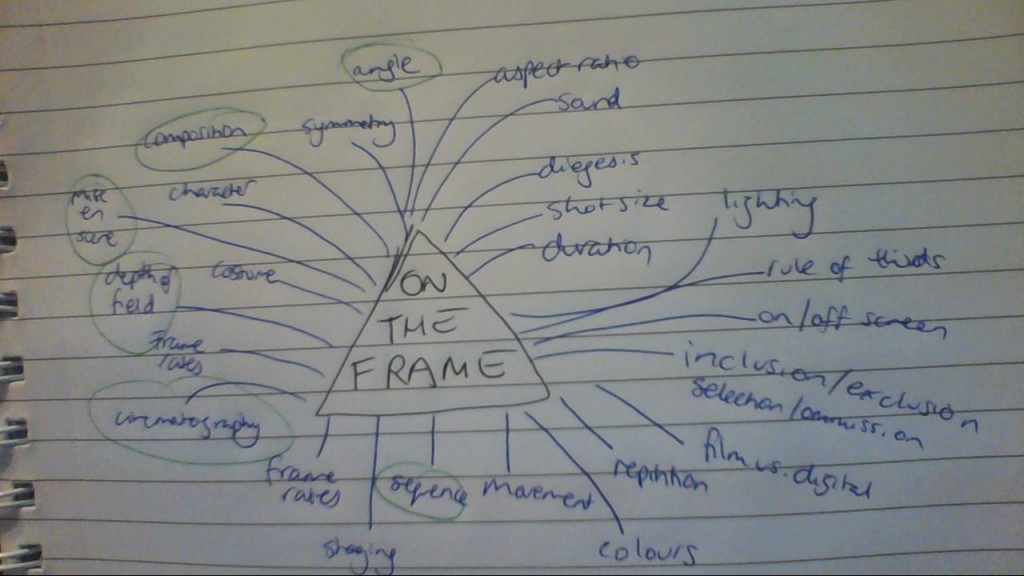Like all the best subjects – nay, all the best things in life – On The Frame started with an outing. To begin to understand the significance of framing, Dan sent us to the NGV on Thursday to have a look at some paintings.
The previous Tuesday’s class had been an introduction to the subject (and to each other), and as part of that Dan had asked us to brainstorm any and all terms that came to mind when thinking about the things we’d be learning this semester. This is what we came up with as a class:
You’ll notice that some of the phrases are circled. That’s because Dan asked us to pick four or five of these elements that interested us the most and that we particularly wanted to learn about. In case you can’t read my terrible pig-scratching hand-writing, mine were:
- Mise-en-scene
- Composition
- Angle
- Depth of Field
- Sequence
- Cinematography
Okay, I know that’s six but I thought ‘cinematography’ covered the others.
When we got to the gallery, Dan told us to find three artworks that addressed our four or five elements (I dropped cinematography for this task) and discuss them, including references to the actual, literal frame (or lack thereof).
To be honest, I found the gallery so engrossing that I kind of forgot about the task; with only one picture noted and only a quarter of the exhibits explored I was kindly informed via loudspeaker that the gallery would be shutting in half an hour. Hence why you’ll notice all of my selections come from the medieval European collection.
1. The Virgin and Child by Simon Marmion (1425-89)
Picture sourced from http://www.ngv.vic.gov.au/explore/collection/work/4166/
I picked this painting because reading the description and observing it closely I felt it spoke to my elements of mise-en-scene and depth of field. The picture’s description mentioned how the Virgin Mary is pictured here not in a biblical scene but in a contemporary European setting, with blond hair and fine features that were idealised at the time of production. Furthermore, the mise-en-scene of the way Christ is laying in Mary’s arms is supposed to refer to other depictions of ‘La Pieta’, a popular image in medieval times of Christ dying in a weeping Mary’s arms (despite the fact this is never actually described in the bible). Furthermore, I found the depth of field quite sophisticated if only in the sense that it is aesthetically pleasing; there is quite a long expanse behind the foreground – I think I counted six layers. The frame of this small painting (about A4 size, I would guess) was plain brown wood, which I thought served to highlight the vibrant greens and blues worn by Mary.
2. Rest on the Flight Into Egypt With St Catherine and Angels by Paris Bordone, 1527-30
Picture sourced from http://www.ngv.vic.gov.au/essay/paris-bordones-rest-on-the-flight-into-egypt/
I found this picture to be quite beautiful, and I think part of the reason for this was its composition (one of my elements). I think the artist uses the concepts of the rule of thirds points of interest to create that quite clear diagonal line from bottom left to top right made up of the subjects’ heads. I think the use of that diagonal to separate the main subjects from the background is somehow very pleasing to the eye. As part of composition I thought this picture also spoke to my element of angle, as the picture seems to be painted from just below straight on (or eye level), adding to the height of the action created by the composition of the diagonal and the placement of the cherubs in the tree.
3. The Crossing of The Red Sea by Nicolas Poussin, 1632-34
Picture sourced from http://www.ngv.vic.gov.au/explore/collection/work/4271/
As we were limited to paintings and drawings rather than sculpture, photography or multi-media, I found sequence the hardest of my elements to find represented in the gallery. I chose this painting because I think it evokes movement the best out of the works I saw in the gallery. The way the clouds and waves are positioned to the right of the frame makes it seem as though they are entering the picture, and I think this effect is added to by the way the subjects are reaching to that side; one man is even in the act of pulling another out of the waves, adding to that sense of movement from right to left. I thought the frame was also significant in adding to this sense of movement. It was a large painting (maybe six or seven feet long by four feet high) and it was bordered by a very thick golden frame, inlaid with an intricate design that I felt combined with the chaotic busyness of the picture to evoke movement.
